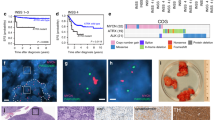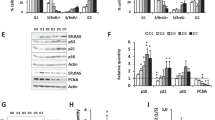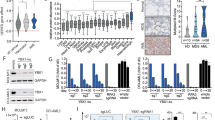Abstract
Mutations leading to aberrant cytoplasmic localization of Nucleophosmin 1 (NPM1) have been recently identified as the most frequent genetic alteration in acute myelogenous leukemia. However, the oncogenic potential of this nucleophosmin mutant (NPMc+) has never been established, which casts doubt on its role in leukemogenesis. By performing classical transformation assays, we find that NPMc+, but not wild-type NPM, cooperates specifically with adenovirus E1A to transform primary mouse embryonic fibroblasts in soft agar. We demonstrate that NPMc+ blocks the p19Arf (Arf) induction elicited by E1A. Surprisingly, however, we find that NPMc+ induces cellular senescence and that E1A is able to overcome this response. We propose a model whereby the NPMc+ pro-senescence activity needs to be evaded for oncogenic transformation, even though NPMc+ can concomitantly blunt the Arf/p53 pathway. These findings identify for the first time NPMc+ as an oncogene and shed new unexpected light on its mechanism of action.
This is a preview of subscription content, access via your institution
Access options
Subscribe to this journal
Receive 50 print issues and online access
$259.00 per year
only $5.18 per issue
Buy this article
- Purchase on Springer Link
- Instant access to full article PDF
Prices may be subject to local taxes which are calculated during checkout






Similar content being viewed by others
References
Bartkova J, Rezaei N, Liontos M, Karakaidos P, Kletsas D, Issaeva D et al. (2006). Oncogene-induced senescence is part of the tumorigenesis barrier imposed by DNA damage checkpoints. Nature 444: 633–637.
Berk AJ . (2005). Recent lessons in gene expression, cell cycle control, and cell biology from adenovirus. Oncogene 24: 7673–7685.
Colombo E, Bonetti P, Lazzerini Denchi E, Martinelli P, Zamponi R, Marine JC et al. (2005). Nucleophosmin is required for DNA integrity and p19Arf protein stability. Mol Cell Biol 25: 8874–8886.
Colombo E, Marine JC, Danovi D, Falini B, Pelicci PG . (2002). Nucleophosmin regulates the stability and transcriptional activity of p53. Nat Cell Biol 4: 529–533.
Colombo E, Martinelli P, Zamponi R, Shing DC, Bonetti P, Luzi L et al. (2006). Delocalization and destabilization of the Arf tumor suppressor by the leukemia-associated NPM mutant. Cancer Res 66: 3044–3050.
de Stanchina E, McCurrach ME, Zindy F, Shieh SY, Ferbeyre G, Samuelson AV et al. (1998). E1A signaling to p53 involves the p19(ARF) tumor suppressor. Genes Dev 12: 2434–2442.
Den Besten W, Kuo ML, Williams RT, Sherr CJ . (2005). Myeloid leukemia-associated nucleophosmin mutants perturb p53-dependent and independent activities of the Arf tumor suppressor protein. Cell Cycle 4: 1593–1598.
Di Micco R, Fumagalli M, Cicalese A, Piccinin S, Gasparini P, Luise C et al. (2006). Oncogene-induced senescence is a DNA damage response triggered by DNA hyper-replication. Nature 444: 638–642.
Dyson N, Harlow E . (1992). Adenovirus E1A targets key regulators of cell proliferation. Cancer Surv 12: 161–195.
Falini B, Bolli N, Shan J, Martelli MP, Liso A, Pucciarini A et al. (2006). Both carboxy-terminus NES motif and mutated tryptophan(s) are crucial for aberrant nuclear export of nucleophosmin leukemic mutants in NPMc+ AML. Blood 107: 4514–4523.
Falini B, Mecucci C, Tiacci E, Alcalay M, Rosatio R, Pasqualucci L et al. (2005). Cytoplasmic nucleophosmin in acute myelogenous leukemia with a normal karyotype. N Engl J Med 352: 254–266.
Frehlick LJ, Eirin-Lopez JM, Ausio J. (2007). New insights into the nucleophosmin/nucleoplasmin family of nuclear chaperones. Bioessays 29: 49–59.
Gallimore PH, Turnell AS . (2001). Adenovirus E1A: remodelling the host cell, a life or death experience. Oncogene 20: 7824–7835.
Grisendi S, Bernardi R, Rossi M, Cheng K, Khandker L, Manova K et al. (2005). Role of nucleophosmin in embryonic development and tumorigenesis. Nature 437: 147–153.
Grisendi S, Mecucci C, Falini B, Pandolfi PP . (2006). Nucleophosmin and cancer. Nat Rev Cancer 6: 493–505.
Grossman SR, Perez M, Kung AL, Joseph M, Mansur C, Xiao ZX et al. (1998). p300/MDM2 complexes participate in MDM2-mediated p53 degradation. Mol Cell 2: 405–415.
Kondo T, Minamino N, Nagamura-Inoue T, Matsumoto M, Taniguchi T, Tanaka N . (1997). Identification and characterization of nucleophosmin/B23/numatrin which binds the anti-oncogenic transcription factor IRF-1 and manifests oncogenic activity. Oncogene 15: 1275–1281.
Krug U, Ganser A, Koeffler HP . (2002). Tumor suppressor genes in normal and malignant hematopoiesis. Oncogene 21: 3475–3495.
Land H, Parada LF, Weinberg RA . (1983). Tumorigenic conversion of primary embryo fibroblasts requires at least two cooperating oncogenes. Nature 304: 596–602.
Lin CY, Liang YC, Yung BY . (2006). Nucleophosmin/B23 regulates transcriptional activation of E2F1 via modulating the promoter binding of NF-kappaB, E2F1 and pRb. Cell Signal 18: 2041–2048.
Lin HJ, Eviner V, Prendergast GC, White E . (1995). Activated H-ras rescues E1A-induced apoptosis and cooperates with E1A to overcome p53-dependent growth arrest. Mol Cell Biol 15: 4536–4544.
Mendes-da-Silva P, Moreira A, Duro-da-Costa J, Matias D, Monteiro C . (2000). Frequent loss of heterozygosity on chromosome 5 in non-small cell lung carcinoma. Mol Pathol 53: 184–187.
Morris SW, Kirstein MN, Valentine MB, Dittmer KG, Shapiro DN, Saltman DL et al. (1994). Fusion of a kinase gene, ALK, to a nucleolar protein gene, NPM, in non-Hodgkin's lymphoma. Science 263: 1281–1284.
Olney HJ, Le Beau MM . (2002). The Myelodysplastic Syndromes, Pathobiology and Clinical Management. Marcel Dekker: New York, pp 89–120.
Palmero I, Pantoja C, Serrano M . (1998). p19ARF links the tumour suppressor p53 to Ras. Nature 395: 125–126.
Redner RL, Rush EA, Faas S, Rudert WA, Corey SJ . (1996). The t(5;17) variant of acute promyelocytic leukemia expresses a nucleophosmin-retinoic acid receptor fusion. Blood 87: 882–886.
Ruley HE . (1983). Adenovirus early region 1A enables viral and cellular transforming genes to transform primary cells in culture. Nature 304: 602–606.
Sauerbrey A, Stammler G, Zintl F, Volm M . (1998). Expression of the retinoblastoma tumor suppressor gene (RB-1) in acute leukemia. Leuk Lymphoma 28: 275–283.
Serrano M, Lin AW, McCurrach ME, Beach D, Lowe SW . (1997). Oncogenic ras provokes premature cell senescence associated with accumulation of p53 and p16INK4a. Cell 88: 593–602.
Sherr CJ . (2006). Divorcing ARF and p53: an unsettled case. Nat Rev Cancer 6: 663–673.
Thiede C, Koch S, Creutzig E, Steudel C, Illmer T, Schaich M et al. (2006). Prevalence and prognostic impact of NPM1 mutations in 1485 adult patients with acute myeloid leukemia (AML). Blood 107: 4011–4020.
Vassilev LT, Vu BT, Graves B, Carvajal D, Podlaski F, Filipovic Z et al. (2004). In vivo activation of the p53 pathway by small-molecule antagonists of MDM2. Science 303: 844–848.
Verhaak RG, Goudswaard CS, van Putten W, Bijl MA, Sanders MA, Hugens W et al. (2005). Mutations in nucleophosmin (NPM1) in acute myeloid leukemia (AML): association with other gene abnormalities and previously established gene expression signatures and their favorable prognostic significance. Blood 106: 3747–3754.
Yew PR, Berk AJ . (1992). Inhibition of p53 transactivation required for transformation by adenovirus early 1B protein. Nature 357: 82–85.
Yoneda-Kato N, Look AT, Kirstein MN, Valentine MB, Raimondi SC, Cohen KJ et al. (1996). The t(3;5)(q25.1;q34) of myelodysplastic syndrome and acute myeloid leukemia produces a novel fusion gene, NPM-MLF1. Oncogene 12: 265–275.
Zhang X, Turnell AS, Gorbea C, Mymryk JS, Gallimore PH, Grand RJ . (2004). The targeting of the proteasomal regulatory subunit S2 by adenovirus E1A causes inhibition of proteasomal activity and increased p53 expression. J Biol Chem 279: 25122–25133.
Acknowledgements
We thank Dr G Gilliland for providing us the MSCV Flt3-ITD plasmid and Dr B Falini for the NPMc+ polyclonal antibody. We are grateful to C Nardella, Z Chen and H Lin and all members of PPP laboratory for discussions and critical reading of the manuscript.
Author information
Authors and Affiliations
Corresponding author
Additional information
Supplementary Information accompanies the paper on the Oncogene website (http://www.nature.com/onc).
Supplementary information
Rights and permissions
About this article
Cite this article
Cheng, K., Grisendi, S., Clohessy, J. et al. The leukemia-associated cytoplasmic nucleophosmin mutant is an oncogene with paradoxical functions: Arf inactivation and induction of cellular senescence. Oncogene 26, 7391–7400 (2007). https://doi.org/10.1038/sj.onc.1210549
Received:
Revised:
Accepted:
Published:
Issue Date:
DOI: https://doi.org/10.1038/sj.onc.1210549
Keywords
This article is cited by
-
Integrated Analysis of Copy Number Variations and Gene Expression Profiling in Hepatocellular carcinoma
Scientific Reports (2017)
-
Mutated NPM1 in combination with overexpression of Meis1 or Hoxa9 is not sufficient to induce acute myeloid leukemia
Experimental Hematology & Oncology (2015)
-
Mouse models of NPM1-mutated acute myeloid leukemia: biological and clinical implications
Leukemia (2015)
-
A short acidic motif in ARF guards against mitochondrial dysfunction and melanoma susceptibility
Nature Communications (2014)
-
Nucleophosmin and its complex network: a possible therapeutic target in hematological diseases
Oncogene (2011)



